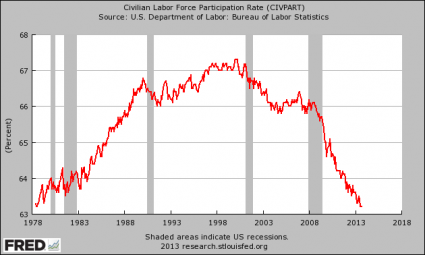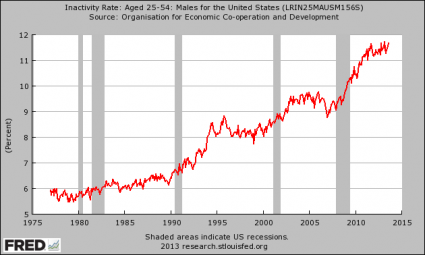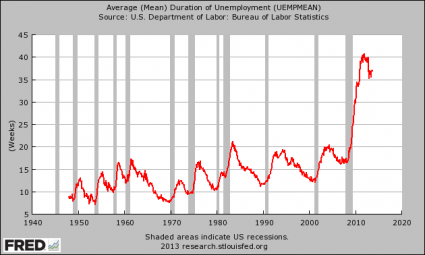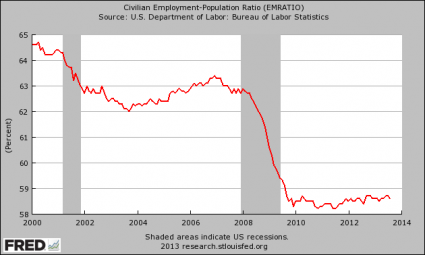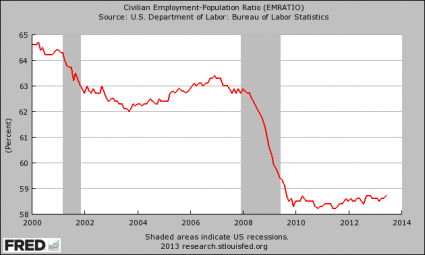 What are human workers going to do when super-intelligent robots and computers are better than us at doing everything? That is one of the questions that a new study by Dr. Carl Frey and Dr. Michael Osborne of Oxford University sought to address, and what they concluded was that 47 percent of all U.S. jobs could be automated within the next 20 years. Considering the fact that the percentage of the U.S. population that is employed is already far lower than it was a decade ago, it is frightening to think that tens of millions more jobs could disappear due to technological advances over the next couple of decades. I have written extensively about how we are already losing millions of jobs to super cheap labor on the other side of the globe. What are middle class families going to do as technology also takes away huge numbers of our jobs at an ever increasing pace? We live during a period of history when knowledge is increasing an an exponential rate. In the past, when human workers were displaced by technology it also created new kinds of jobs that the world had never seen before. But what happens when the day arrives when computers and robots can do almost everything more cheaply and more efficiently than humans can?
What are human workers going to do when super-intelligent robots and computers are better than us at doing everything? That is one of the questions that a new study by Dr. Carl Frey and Dr. Michael Osborne of Oxford University sought to address, and what they concluded was that 47 percent of all U.S. jobs could be automated within the next 20 years. Considering the fact that the percentage of the U.S. population that is employed is already far lower than it was a decade ago, it is frightening to think that tens of millions more jobs could disappear due to technological advances over the next couple of decades. I have written extensively about how we are already losing millions of jobs to super cheap labor on the other side of the globe. What are middle class families going to do as technology also takes away huge numbers of our jobs at an ever increasing pace? We live during a period of history when knowledge is increasing an an exponential rate. In the past, when human workers were displaced by technology it also created new kinds of jobs that the world had never seen before. But what happens when the day arrives when computers and robots can do almost everything more cheaply and more efficiently than humans can?
For employers, there are a whole host of advantages that come with replacing human workers with technology. Robots and computers never complain, they never get tired, they never need vacation, they never show up late, they never waste time on Facebook, they don’t need any health benefits and there are a vast array of rules, regulations and taxes that you must deal with when you hire a human worker.
If you could get a task done more cheaply and more efficiently by replacing a human worker with technology, why wouldn’t you want to do it?
We are already starting to see this happen on a mass scale, and according to Dr. Frey and Dr. Osborne, close to half of all of our jobs could be automated within the next 20 years. A recent article posted on smartplanet.com described how this process might play out…
The automation of half the nation’s jobs will occur in two phases, the study says: The first wave will affect (and is affecting) jobs in transportation/logistics, production labor, administrative support, services, sales, and construction. The second wave — propelled by artificial intelligence — will affect jobs in management, science, engineering, and the arts.
Just as interesting as the study is the response provided by Gary Reber, founder and executive director of For Economic Justice, who argues that owners of the means of production will actually thrive as such a shift takes place. Those who rely on 9-to-5 standard employment arrangements for subsistence are likely to suffer the most in the automation wave. As Reber put it: ‘Full employment is not an objective of businesses. Companies strive to keep labor input and other costs at a minimum.”
This is one of the reasons why the U.S. economy will never produce enough jobs for everyone ever again.
If technology can outperform humans, it is only rational for companies to replace humans with technology.
And this is even starting to happen in fields that require very high levels of education.
Just look at what is happening in the medical field. Today, millions of people turn to websites such as WebMD for their medical needs, but this is only just the beginning. Check out this excerpt from a recent Bloomberg article entitled “Doctor Robot Will See You Shortly“…
Johnson & Johnson proposes to replace anesthesiologists during simple procedures such as colonoscopies — not with nurse practitioners, but with machines. Sedasys, which dispenses propofol and monitors a patient automatically, was recently approved for use in healthy adult patients who have no particular risk of complications. Johnson & Johnson will lease the machines to doctor’s offices for $150 per procedure — cleverly set well below the $600 to $2,000 that anesthesiologists usually charge.
Certainly we will always need doctors.
But many of the tasks that doctors once performed will now be performed by technology.
For example, have you heard about “OnStar for the Body” yet? Some of these new “wearable technologies” are more than a little bit creepy…
Smart, cheaper and point-of-care sensors, such as those being developed for the Nokia Sensing XCHALLENGE, will further enable the ‘Digital Checkup’ from anywhere. The world of ‘Quantified Self’ and ‘Quantified Health’ will lead to a new generation of wearable technologies partnered with Artificial Intelligence that will help decipher and make this information actionable.
And this ‘actionability’ is key. We hear the term Big Data used in various contexts; when applied to health information it will likely be the smart integration of massive data sets from the ‘Internet of things’ with the small data about your activity, mood, and other information. When properly filtered, this data set can give insights on a macro level – population health – and micro – ‘OnStar for the Body‘ with a personalized ‘check engine light’ to help identify individual problems before they further develop into expensive, difficult-to-treat or fatal conditions.
We are also seeing humans being replaced in other fields as well. For instance, DARPA has developed a robot named “Atlas” that it hopes will be used in “disaster-response scenarios”…
DARPA’s Virtual Robotics Challenge entered a new phase in July, when Atlas — a 6-foot-2-inch, 330-pound robot developed by Boston Dynamics — was introduced to seven teams tasked with training it for disaster-response scenarios. The end goal? “Supervised autonomy” so that Atlas and its successors can step into situations too dangerous for humans.
I don’t know about you, but I don’t really want “Terminator” to show up when my family is in the middle of a disaster, but this is where things are headed.
And as technology increases, a lot of good paying middle class jobs are going to be vulnerable. In fact, one study of employment data that examined statistics from 20 countries found that “almost all the jobs disappearing are in industries that pay middle-class wages, ranging from $38,000 to $68,000.”
Those are exactly the sort of “breadwinner jobs” that middle class families rely upon.
And of course working class jobs are being replaced by technology as well. According to MIT Technology Review, a $22,000 humanoid robot named Baxter has been developed that can easily be programmed to do jobs that have never been automated before…
Brooks’s company, Rethink Robotics, says the robot will spark a “renaissance” in American manufacturing by helping small companies compete against low-wage offshore labor. Baxter will do that by accelerating a trend of factory efficiency that’s eliminated more jobs in the U.S. than overseas competition has. Of the approximately 5.8 million manufacturing jobs the U.S. lost between 2000 and 2010, according to McKinsey Global Institute, two-thirds were lost because of higher productivity and only 20 percent moved to places like China, Mexico, or Thailand.
The ultimate goal is for robots like Baxter to take over more complex tasks, such as fitting together parts on an electronics assembly line. “A couple more ticks of Moore’s Law and you’ve got automation that works more cheaply than Chinese labor does,” Andrew McAfee, an MIT researcher, predicted last year at a conference in Tucson, Arizona, where Baxter was discussed.
So what are human workers going to do when robots are making all of our products?
That is a very good question.
Incredibly, robots are now even replacing human factory workers in China. The following comes from a recent TechCrunch article…
Foxconn has been planning to buy 1 million robots to replace human workers and it looks like that change, albeit gradual, is about to start.
The company is allegedly paying $25,000 per robot – about three times a worker’s average salary – and they will replace humans in assembly tasks. The plans have been in place for a while – I spoke to Foxconn reps about this a year ago – and it makes perfect sense. Humans are messy, they want more money, and having a half-a-million of them in one factory is a recipe for unrest. But what happens after the halls are clear of careful young men and women and instead full of whirring robots?
So who benefits from all of this?
Those that own the big corporations that dominate our economy certainly benefit. They aren’t going to need to hire as many of us to work for them, and they are going to make even bigger profits than before.
Meanwhile, the gap between the wealthy and the poor will grow even larger. The only thing that most people have to offer in the economic marketplace is their labor, and the demand for that labor is decreasing with each passing day.
What do you think will happen to society when most of us are no longer “needed”?
Could we be headed for big trouble as a society?
And if you think that your job could “never be automated”, you might want to think again.
We are rapidly getting to the point where even driving will be automated…
Brace yourself. In a few years, your car will be able to drop you off at the door of a shopping center or airport terminal, go park itself and return when summoned with a smartphone app. Audi demonstrated such a system at this year’s Consumer Electronics Show.
At your next dinner party, ask for a show of hands of the people who’d want that.
Everybody?
Anybody want a car that doesn’t crash? At this month’s Frankfurt auto show, mega-auto supplier Continental announced a partnership with IBM to help bring autonomous vehicles to market, with “zero accidents” as a possible result. Volvo has promised to injury-proof its cars by 2020. GM and Carnegie Mellon aim to develop autonomous technology to eliminate car accidents.
So what will happen to the 3.1 million Americans that drive trucks for a living once all driving is automated?
What will happen to the millions of other Americans that drive buses, taxis and limos once all driving is automated?
That is something to think about.
And researchers are even trying to create computers that “seem human” when you have a conversation with them…
On 14 September, researchers will gathered in Derry, Northern Ireland, to demonstrate their latest efforts. If any of them has created a machine that successfully mimics a human, they will leave $100,000 richer.
The money is being put up by Hugh Loebner, a New York based philanthropist. His goal, he says, is total unemployment for all human beings throughout the world. He wants robots to do all the work. And the first step towards that is apparently to develop computers that seem human when you chat to them.
So if your job involves a telephone, you are in danger of being phased out. In fact, this transition is already starting to happen…
IPsoft is a young company started by Chetan Dube, a former mathematics professor at New York University. He reckons that artificial intelligence can take over most of the routine information-technology and business-process tasks currently performed by workers in offshore locations. “The last decade was about replacing labour with cheaper labour,” says Mr Dube. “The coming decade will be about replacing cheaper labour with autonomics.”
IPsoft’s Eliza, a “virtual service-desk employee” that learns on the job and can reply to e-mail, answer phone calls and hold conversations, is being tested by several multinationals. At one American media giant she is answering 62,000 calls a month from the firm’s information-technology staff. She is able to solve two out of three of the problems without human help. At IPsoft’s media-industry customer Eliza has replaced India’s Tata Consulting Services.
We truly are entering an unprecedented time in human history.
Instead of robots violently taking over society like so many movies have portrayed, they are slowly starting to “replace” us instead. A recent Wired article described what this transition might look like as it picks up steam…
First, machines will consolidate their gains in already-automated industries. After robots finish replacing assembly line workers, they will replace the workers in warehouses. Speedy bots able to lift 150 pounds all day long will retrieve boxes, sort them, and load them onto trucks. Fruit and vegetable picking will continue to be robotized until no humans pick outside of specialty farms. Pharmacies will feature a single pill-dispensing robot in the back while the pharmacists focus on patient consulting. Next, the more dexterous chores of cleaning in offices and schools will be taken over by late-night robots, starting with easy-to-do floors and windows and eventually getting to toilets. The highway legs of long-haul trucking routes will be driven by robots embedded in truck cabs.
All the while, robots will continue their migration into white-collar work. We already have artificial intelligence in many of our machines; we just don’t call it that. Witness one piece of software by Narrative Science (profiled in issue 20.05) that can write newspaper stories about sports games directly from the games’ stats or generate a synopsis of a company’s stock performance each day from bits of text around the web. Any job dealing with reams of paperwork will be taken over by bots, including much of medicine. Even those areas of medicine not defined by paperwork, such as surgery, are becoming increasingly robotic. The rote tasks of any information-intensive job can be automated. It doesn’t matter if you are a doctor, lawyer, architect, reporter, or even programmer: The robot takeover will be epic.
Are you ready for the “robot takeover”?
The world of employment is never going to be the same again. Technology has already surpassed human workers in a whole host of arenas, and this transition is only going to become more rapid in the years ahead.
So what does this mean for the rest of us? Please feel free to share your thoughts by posting a comment below…
 The percentage of Americans that are participating in the labor force is the lowest that it has been in 35 years. During the 70s, 80s and 90s, the labor force participation rate consistently rose as large numbers of women entered the workforce. It peaked at 67.3 percent in early 2000, and just before the last recession it was sitting at about 66 percent. Since the start of the last recession, the labor force participation rate has not stopped falling and it is now at a 35 year low. In September, 11,255,000 Americans were considered to be “unemployed”, and an astounding 90,609,000 Americans were considered to be “not in the labor force”. The number of Americans “not in the labor force” has increased by more than 10 million since Barack Obama entered the White House. When you add the number of unemployed Americans to the number of Americans “not in the labor force”, you come up with a grand total of more than 101 million working age Americans that do not have a job.
The percentage of Americans that are participating in the labor force is the lowest that it has been in 35 years. During the 70s, 80s and 90s, the labor force participation rate consistently rose as large numbers of women entered the workforce. It peaked at 67.3 percent in early 2000, and just before the last recession it was sitting at about 66 percent. Since the start of the last recession, the labor force participation rate has not stopped falling and it is now at a 35 year low. In September, 11,255,000 Americans were considered to be “unemployed”, and an astounding 90,609,000 Americans were considered to be “not in the labor force”. The number of Americans “not in the labor force” has increased by more than 10 million since Barack Obama entered the White House. When you add the number of unemployed Americans to the number of Americans “not in the labor force”, you come up with a grand total of more than 101 million working age Americans that do not have a job.